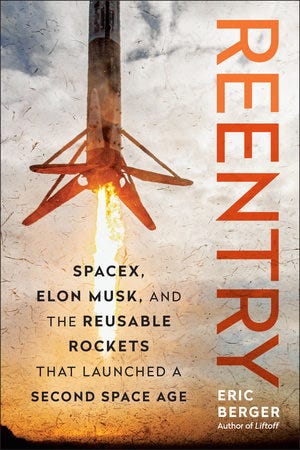On October 13, SpaceX and Elon Musk successfully launched their Starship rocket into low-Earth orbit. Then, in a milestone moment for space technology, they successfully captured the rocket’s Super Heavy booster with “chopstick” arms on the launch tower upon reentry, marking the first time a booster was ever caught in mid-air.
The achievement is a mind-blowing feat of human engineering — one that hasn’t gotten nearly the recognition that it deserves. Today on Faster, Please! — The Podcast, I talk with must-read space journalist Eric Berger about the role of SpaceX in the new, 21st-century Space Race, the significance of the company’s achievements, and our potential to become a spacefaring, inter-planetary species.
Berger is the senior space editor at Ars Techica, and is the author of both Liftoff: Elon Musk and the Desperate Early Days that Launched SpaceX and his most recent excellent book, Reentry: SpaceX, Elon Musk, and the Reusable Rockets that Launched a Second Space Age.
In This Episode
Starship’s big reentry (1:43)
Race (back) to the moon (8:54)
Why Starship? (11:48)
The Mars-shot (18:37)
Elon in the political area (22:10)
Understanding SpaceX (24:06)
Below is a lightly edited transcript of our conversation
Starship’s big reentry (1:43)
James Pethokoukis: After the launch tower caught that booster stage of the rocket, I saw someone on Twitter a day later say, “Hey, do you guys remember over the weekend when SpaceX sent a Statue-of-Liberty-sized object to space and then caught it when it came back down? That was amazing!”
So two things: First, as a space guy, what was your reaction? Two, beyond the sheer coolness of it, why was this an important thing to happen?
It seemed inconceivable a few years ago, but now, all of a sudden, it's the future of rocketry, just like that.
Eric Berger: Just from a space perspective, it’s epic to see, to use your adjectives, the Statue of Liberty comparison. I mean, it's a small skyscraper, but they essentially launch that thing to space at thousands of miles per hour, then it slows down, it comes back right where it took off from, hovers, and it falls precisely into these two arms that are designed to catch it. The cool thing is that we'd never seen anything like that before. It seemed inconceivable a few years ago, but now, all of a sudden, it's the future of rocketry, just like that.
the significance of this, of course, is SpaceX has shown that with the reusability of the Falcon 9 rocket, it can really change the economics of launch. This year they've launched 101 times. No country had ever done that many launches before in a year. They're going to launch 95 percent of all the mass into orbit this year with primarily the Falcon 9 Rocket, and all that's because the first stage is entirely reusable, they're flying them more than 20 times now, and so they're just taking that and scaling it.
What was amazing about the tower catch this weekend was the fact that it really removes the need for landing legs. You may think, “Well, what's the big deal about that?” Well, there's a lot of mass involved with those landing legs: You need powerful actuators to drive them, you need hydraulic fluid, and that's a lot of dead mass in the vehicle. Also, it's not insignificant to transport the rocket from wherever it lands, either on a boat or on land, to the factory and to refurbish the rocket and launch again. Ideally, with this step, they're eliminating days from that process of reuse and ideally, in the future, they're literally going to be catching the rocket, setting it back on the launch mount and then potentially flying again.
So it's not just the Starship, right? So for the other launches, is this is going to become the landing procedure?
No, it will be just for Starship. They will continue to fly Falcon 9 as is. That's a mature product, everyone's pretty comfortable with that vehicle. But, look, other companies have tried different things. When Rocket Lab was trying to reuse its small Electron vehicle, its plan was to have the first stage come back under a parachute and then basically swoop in with a helicopter and catch it so that the rocket didn't fall into the ocean. That ended up not working.
It seems very whimsical.
Well, it made sense from an engineering standpoint, but it was a lot more difficult to snag the rocket than they ended up finding out. So, up until now, the only way to get a rocket back vertically was on a drone ship or landing straight up, and so this is a brand new thing, and it just creates more efficiencies in the launch system.
What is the direction now, as far as launch costs and the continued decline of launch costs if this will be the new landing procedure for Starship?
It's impossible to say that, of course. We can look to a Falcon 9 for an analog. SpaceX sales started out selling Falcon 9 for $60 million, it's upped that price to about $67 or $68 million — still the lowest-cost medium-lift launch vehicle in the world, but that's the price you or I or NASA would pay for a rocket. Internally, the estimate is that they're re-flying those vehicles for about $15 million. So, in effect, SpaceX has taken the cost of the lowest-price vehicle on the market and divided it by four, basically.
Starship, of course, can lift much more payload to orbit than Falcon 9. By some measures, five to 10 times as much, eventually. And so if they can get the cost down, if they can make the first and second stage reusable, I think you're talking about them bringing the cost down potentially another order of magnitude, but they've got a lot of work to get there.
I think the second most common comment I saw on social media — the first one being like, “This is amazing, I'm crying, this is so cool” — the second one is, “Why is NASA not using this Starship to get to the moon?” It seems like progress is being made quickly, and you mentioned the costs, I think people are just befuddled. It's a question you must get a lot.
The reality is that if we want to go to the moon before 2030, we probably need to do it with a combination of NASA's Space Launch System rocket and Starship.
It's a complicated answer, but the reality is that NASA, in conjunction with Congress, has basically, over the last quarter of a century, pivoted away from reusable launch vehicles, and at one point in the early 2000s, they were actually funding three different reusable launch vehicles. The most famous of those, of course, was the Space Shuttle. It stopped funding the Space Shuttle in 2011 and it went back to developing this large, expendable rocket called the Space Launch System. That was the tried and true pathway, and no one really had faith in what SpaceX is doing. And so now here we are, almost 15 years later, and SpaceX has gone out and proved it with the Falcon 9, the Falcon Heavy, and now Starship.
The reality is that if we want to go to the moon before 2030, we probably need to do it with a combination of NASA's Space Launch System rocket and Starship. In 2021, NASA did select Starship as its lunar lander. So Starship is a critical part of the architecture. Probably the most challenging part, actually, is getting down to the lunar surface and then getting back up reliably. And so Starship plays a key role, and I just really think that it's inevitable that Starship and potentially Blue Origin’s architecture will be how humans get to the moon and back, but we're kind of in an interim period right now.
Is it just sort of too late to switch?
Yeah, it is. It's too late to switch. You could conceive of scenarios in which humans launch in Crew Dragon, transfer over to a Starship, and then come back in Crew Dragon, but even then you've got some challenges. And the problem — problem is the wrong word, but one of the major issues with Starship is that it has no redundancy when you come back and land. It has got to nail the landing or people inside of it die. So you're going to want to see hundreds of Starship launches and many, many successful landings in a row before you put people on the vehicle. And to have the idea of launching humans from Earth to the moon at this point, we're pretty far from that. I would think a decade from now, at least, and by then China will be on the moon. And so it's really a matter of, do you want to sort of continue to delay the human return of the moon, or do you want to take the tools that you have now and make your best run for it?
Race (back) to the moon (8:54)
Since you brought it up, are we going to beat China to the moon with the SLS?
Very much an open question. The SLS Rocket is basically ready. In its current form, it performed very well during Artemis I. It's obviously super expensive. You may have seen the Europa Clipper launch on Monday of this week, that launched on a Falcon Heavy. For almost a decade, Congress mandated NASA that it launched on the SLS rocket, and that would've cost 10 times as much. NASA paid about $200 million for the Clipper launch on Falcon Heavy, SLS would've been in excess of $2 billion, so it's a very expensive rocket, but it does work, it worked well during Artemis I. The best way we have right now, Jim, to get astronauts from Earth out to lunar orbit is SLS and the Orion deep spacecraft vehicle. That will change over time, but I think if we want to put humans on the moon this decade, that's probably the best way to do it.
Is it going to be a close call? I don't want to overemphasize the competition aspect, but I guess I would like to see America do it first.
It's going to be close. NASA's current date is 2026 for the Artemis III moon landing. There's no way that happens. I think 2028 is a realistic no-earlier-than date, and the reality is SpaceX has to make a lot of progress on Starship. What they did this past weekend was a great step. I think the key thing about the fact of this weekend's launch is that it was a success. There were no anomalies, there's going to be no investigation, so SpaceX is going to launch again. As long as they continue to have success, then they can start popping these off and get to some of the really key tests like the in-space propellant transfer tests, which they hope to do sometime next year.
[W]hen you're on the moon, there's no launch tower, there's no launch crew, you’ve just got the astronauts inside Starship, and if that vehicle doesn't take off on the moon, the crew's going to die. So it's got to work.
What Starship will do is it'll launch into low-earth orbit, and then it'll be refueled, and it'll go to the moon, and you need lots of launches to refuel it. And then really the key test, I think, is landing on the moon, because the South Pole is pretty craterous, you've got to have high confidence in where you land, and then the big challenge is getting back up to lunar orbit safely.
Think about it: When you watch any rocket launch, you see this very detailed, very intricate launch tower with all these umbilicals, and all of these cables, and power, and telemetry, and stuff, and humans are looking at all this data, and if there's any problem, they abort, right? Well, when you're on the moon, there's no launch tower, there's no launch crew, you’ve just got the astronauts inside Starship, and if that vehicle doesn't take off on the moon, the crew's going to die. So it's got to work. And so that's really a big part of the challenge, as well, is getting all that to work. So I think 2028, for all that to come together, is a realistic no-earlier-than date, and China's pretty consistently said 2030, and they're starting to show off some hardware, they recently demonstrated that suggests they have a chance to make 2030.
On sale everywhere The Conservative Futurist: How To Create the Sci-Fi World We Were Promised
Why Starship? (11:48)
What is the commercial case for Starship, assuming that these next launches continue to go off well? What is it supposed to be doing here on Earth and in Earth orbit?
The next big race is to deliver internet, not to a dish that you set up, but actually to your mobile phone. It's called direct-to-cell, and you need much bigger satellites for this. And so SpaceX needs the Starship to launch these satellites, so that will really be the commercial use case for Starship in the near term.
Its primary function, and I think the most important function for SpaceX in the near term, is launching these much larger Starlink satellites. I think it's been pretty well proven that there's a large demand for broadband internet from low-earth orbit. Starlink has now up to four million customers and they're actually signing almost at an exponential rate. Then growth, the business is profitable. So that's been super impressive. The next big race is to deliver internet, not to a dish that you set up, but actually to your mobile phone. It's called direct-to-cell, and you need much bigger satellites for this. So SpaceX needs the Starship to launch these satellites, so that will really be the commercial use case for Starship in the near term.
I think once the vehicle starts flying reliably, we're going to see where the commercial customers go because we've never really been in a launch environment where you're not really constrained by mass and, more importantly, by volume. You can just build bigger, less-efficient things. Instead of hyper-managing your satellite to be small, and light, and compact, you can kind of make trades where maybe you have a lower-cost vehicle that's bigger. The capability of Starship with its voluminous payload fairing and being able to lift a hundred or more tons to low-earth orbit for low cost — entirely new regime. And so I think it's a case of Field of Dreams, “If you build it, they will come,” and in the near term, Starship will be the business case, and longer-term we'll see some unique opportunities.
You've been covering this for quite a while, documenting, books, including your most recent book. Really an amazing ride as a space journalist for you here.
I've been covering space now for two decades, and really with a focus on commercial space over the last decade because I think that's where a lot of the excitement and innovation is coming from. But the reality is that you've got this whole ecosystem of companies, but the 800-pound gorilla is SpaceX. They're the company that has consistently had success. They are the only provider of crew transportation services for NASA, still, even five years after their initial success, and they're the only provider right now that's launching cargo missions to the space station. They've got huge Starlink satellites, constellation. As a journalist, you really want to understand the biggest, most dominating force in the industry, and that's clearly SpaceX, and so that's why I've chosen to dedicate a lot of time to really understand where they started out and how they got to where they are, which is at the top of the heap.
The story that you lay out in your book, which came out last month — Reentry: SpaceX, Elon Musk, and the Reusable Rockets that Launched a Second Space Age — to me, it’s still a story people mostly don’t know, and one that I think a lot of non-space reporters don’t understand. What are some common misunderstandings that you come across that make you feel like you need to tell this story?
I think, until recently, one of the things that people might say about SpaceX is, “Well, what's the big deal? NASA's launched humans to orbit in the past, NASA's launched cargo, they had a reusable space vehicle in the Space Shuttle.” What's different is that SpaceX is doing this at scale, and they're building for a long-term plan that is sustainable.
I'll give you an example: The Space Shuttle was reusable. Everything was reusable except the external tank. However, you needed a standing army of thousands of people to pour over the Space Shuttle after it came back from space to make sure that all of its tiles and every piece of equipment was safe. Now, when it was originally sold to Congress back in the 1970s, the program manager for the space shuttle, George Mueller said that the goal was to get the cost of payload-to-orbit for the Space Shuttle down to $25 a pound, which sounded great because then they were saying dozens of people could fly on the vehicle at a time. Well, of course, at the end of the day, it only ever flew at a maximum of seven people, and the cost of payload-to-orbit was $25,000. So yes, it was reusable, but it was the kind of thing that was super expensive and you couldn't fly very often. You could do limited things.
It's really the first vehicle we ever developed to go to Mars. SpaceX is doing some of the same things that NASA did, but it's doing them better, faster, and a lot cheaper.
SpaceX is proposing kind of an order-of-magnitude change. We went to the moon in the 1960s with the Lunar Module, and everyone remembers it carried two astronauts down to the lunar surface. And that whole thing launched on a giant stack, the Saturn V rocket. So if you were to take the Lunar Module and replace the astronauts and just use it to deliver cargo to the moon, it could take five tons down to the lunar surface. Starship, in a reusable mode, can take a hundred tons. If you send an expendable version of Starship, it's 200 tons. And oh, by the way, even if you're not bringing that Starship back, you're getting the whole first stage back anyway.
And so that's really the promise here, is you're building a sustainable system in space where it doesn't cost you $6 billion to go to the moon, it costs you half a billion dollars or to go to the moon, and you can then go on and do other things, you can fill your Starship up with methane repellent and go further. It's really the first vehicle we ever developed to go to Mars. SpaceX is doing some of the same things that NASA did, but it's doing them better, faster, and a lot cheaper.
That $25-a-pound number you gave for Space Shuttle, where are we with SpaceX? Where is SpaceX, or where are they and what's their goal in that context?
They're getting down in a couple of thousand dollars a pound with a Falcon 9, and the idea is, potentially, with Starship, you get down to hundreds of dollars a pound or less. They have a big challenge too, right? They're using tiles on Starship as well. They showed some of them off during the webcast this weekend, and I think we have yet to have any kind of information on how reusable, or how rapidly reusable Starship will be, and we'll have to see.
The Mars-shot (18:37)
To the extent the public understands this company — this is my understanding — the point here is to build Starship, to further this satellite business, and then that satellite business will fund the eventual Mars mission and the Mars colonization. I think that's the public perception of what is happening with this business. How accurate is that? Is that how you look at it? I mean, that's how I look at it from my uninformed or less-informed view, but is that really what we're talking about here?
Yeah, fundamentally, I think that is accurate. There is no business case right now to go to Mars. AT&T is not going to pay $5 billion to put an AT&T logo on a Starship and send a crew to Mars. There are no resources right now that we really can conceive of on Mars that would be profitable for humans to go get and bring back to Earth. So then the question is: How do you pay for it?
Financially, the business case for Mars is not entirely clear, so you’ve got to figure out some way to pay for it. That was one reason why Elon Musk ultimately went with Starlink. That would pay for the Mars vision.
Even when settlers went to the New World in the 1500s, 1600s, in United States, they were exporting tobacco and other products back to Europe, and there's no tobacco that we know of on Mars, right? Financially, the business case for Mars is not entirely clear, so you’ve got to figure out some way to pay for it. That was one reason why Elon Musk ultimately went with Starlink. That would pay for the Mars vision.
I think that's still fundamentally the case. It's effectively going to be paying for the entire development of Starship, and then if it becomes highly profitable, SpaceX is not a public company, so they can take those revenues and do whatever they want with them, and Elon has said again and again that his vision is to settle Mars, and he's building the rockets to do it, and he's trying to find the funding through Starlink to accomplish it. That is the vision. We don't know how it's all going to play out, but I think you're fundamentally correct with that.
I think when he mentions Mars, there are some people that just give it a roll of the eye. It just sounds too science fictional, despite the progress being made toward accomplishing that. It sounds like you do not roll your eyes at that.
Well, it's interesting. He first really talked publicly about this in 2016, eight years ago, back when there was no Starship, back when they just were coming off their second Falcon 9 failure in about a year, and you kind of did roll your eyes at it then . . . And then they got the Falcon 9 flying and they started re-flying it and re-flying it. They did Falcon Heavy, and then they started building Starship hardware, and then they started launching Starship, and now they're starting to land Starship, and this is real hardware.
And yes, to be clear, they have a long, long way to go and a lot of technical challenges to overcome, and you need more than just a rocket in a spaceship to get to Mars, you need a lot of other stuff, too: biological, regulatory, there's a lot of work to go, but they are putting down the railroad tracks that will eventually open that up to settlement.
So I would not roll my eyes. This is certainly the only credible chance, I think, for humans to go to Mars in our lifetimes, and if those early missions are successful, you could envision settlements being built there.
Elon in the political arena (22:10)
Given SpaceX's accomplishments and their lead, is that company politics-proof? Obviously there's always going to be controversy about Elon, and Twitter, and who he gives money to, and things he says, but does any of that really matter for SpaceX?
I think it does. We've already seen a couple examples of it, especially with Elon's very public entree into presidential politics over the last several months. I think that does matter. In his fight with Brazil over what he termed as free speech, they were confiscating Starlink, and so they were trying to shut Starlink down in their country, and that directly affects SpaceX. In California, over the last week we have seen a commission vote to try to limit the number of launches Falcon 9 launches from Vandenberg Space Force Base, and they clearly did that because they were uncomfortable with Elon's behavior publicly. So yeah, this is going to bleed over.
Now, in the near term, there will be limited impacts because the US Department of Defense clearly needs SpaceX rockets. They need SpaceX’s Starlink, they use a branded version of it called Starshield for military communications. The launch and Starlink capabilities are essential for the military. NASA is even more reliant on SpaceX for the International Space Station and beyond; the entire moon program runs through Starship, so it's not going to change in the near term, but longer term you could see this having impacts, and it's not clear to me exactly what those would be — I don't think you could really nationalize SpaceX, and I think if you did try to nationalize SpaceX, you would sort of destroy its magic, but I do think there will ultimately be consequences for the Elon's political activity.
Understanding SpaceX (24:06)
About Reentry, is there a particular story in there that you think just really encapsulates, if you want to understand SpaceX, and what it's doing, and where it's come from, this story kind of gets at it?
The point of the book was to tell the story behind the story. A lot of people knew, generally, what SpaceX has accomplished over the last decade, or the last 15 years, but this really takes you behind the scenes and tells the stories of the people who actually did it.
It's a company that's moving so fast forward that, like I said, there are all these challenges they're facing and they're just tackling them one-by-one as they go along.
I think one of the best stories of the book is just how they were making this up as they went along. The very first time they were going to try to land on the barge was in January of 2015, the drone ship landing, and the night before that barge was going to set out to sea, the guy who had developed the barge realized that, wait a minute, if we come back with a rocket this week, we have nowhere to put it in the port of Jacksonville, because they were staging out of Jacksonville at the time. And there had been this whole discussion at SpaceX about where to put these pedestals, but no one had actually done it. That night, he and another engineer stayed up all night drinking red wine and CADing out designs for the pedestals, and they met the concrete pores the next morning and just built these pedestals within 24 hours. It's a company that's moving so fast forward that, like I said, there are all these challenges they're facing and they're just tackling them one-by-one as they go along.
Elon has spoken about there's sort of this window of opportunity open for space. In the United States, at least, it was open and then it kind of closed. We stopped leaving Earth orbit for a while, we couldn't even get our people into Earth orbit; we had to use another country's rockets.
Is this window — whether for space commerce, space exploration — is it sort of permanently open? Are we beyond the point where things can close — because satellites are so important, and because of geopolitics, that window is open and it's staying open for us to go through.
I think he's talking about the window for settlement of Mars and making humans a multi-planetary species. And when he talks about the window closing, I think he means a lot of different things: One, the era of cheaper money could end — and that clearly did happen, right? We've seen interest rates go way up and it's been much more difficult to raise money, although SpaceX has been able to still do that because of their success. I think he's thinking about his own mortality. I believe he's thinking about a major global war that would focus all of our technological efforts here on planet Earth trying to destroy one another. I think he's thinking about nuclear weapons — just all the things that could bring human progress to a screeching halt, and he’s saying, “Look, the window may be 100 years or it may be 20 years.” So he's like, “We should seize the opportunity right now when we have it.”
Micro Reads
▶ Economics
Larry Summers on the Economics of AI - Conversable Economist
Landing Softly Is Just the Beginning - San Francisco Fed
▶ Business
Breaking Up Google Is a Fool’s Game - WSJ Opinion
▶ Policy/Politics
The tragedy of a 50-50 America - FT Opinion
Why Harris and Trump Are Pandering to Crypto Plutocrats - NYT Opinion
Trump’s Tariffs and Economic Risk - WSJ Opinion
China asks: what is an e-bike? - FT Opinion
▶ AI/Digital
Big frontier AI systems will emerge from global, distributed efforts, not just big tech: Meta’s Yann LeCun - Techcircle
▶ Biotech/Health
▶ Clean Energy/Climate
The Energy Transition We Really Should Be Focusing On - RealClearScience
To Fight Climate Change, Clean Up Carbon Markets - Bberg Opinion
A Mexican Electric Car? Only If Private Firms Lead the Way - Bberg Opinion
▶ Robotics/AVs
▶ Space/Transportation
▶ Up Wing/Down Wing
Archimedes Rediscovered: Technology and Ancient History - JSTOR Daily
▶ Substacks/Newsletters
Yes, You’re Still Imagining a Migrant Crime Spree - Alex Nowrasteh's Immigration Insights and Other Deep Dives
How long can we sustain economic growth? - Noahpinion
What is Anthropic's AI Computer Use? - AI Supremacy
An AI intern in your pocket - Exponential View
Industrial Policy’s Inescapable Uncertainty Problem - The Dispatch
NEPA Nightmares IV: Tule Wind - Breakthrough Journal
When you give a Claude a mouse - One Useful Thing
Larry Summers on the Economics of AI - Conversable Economist














